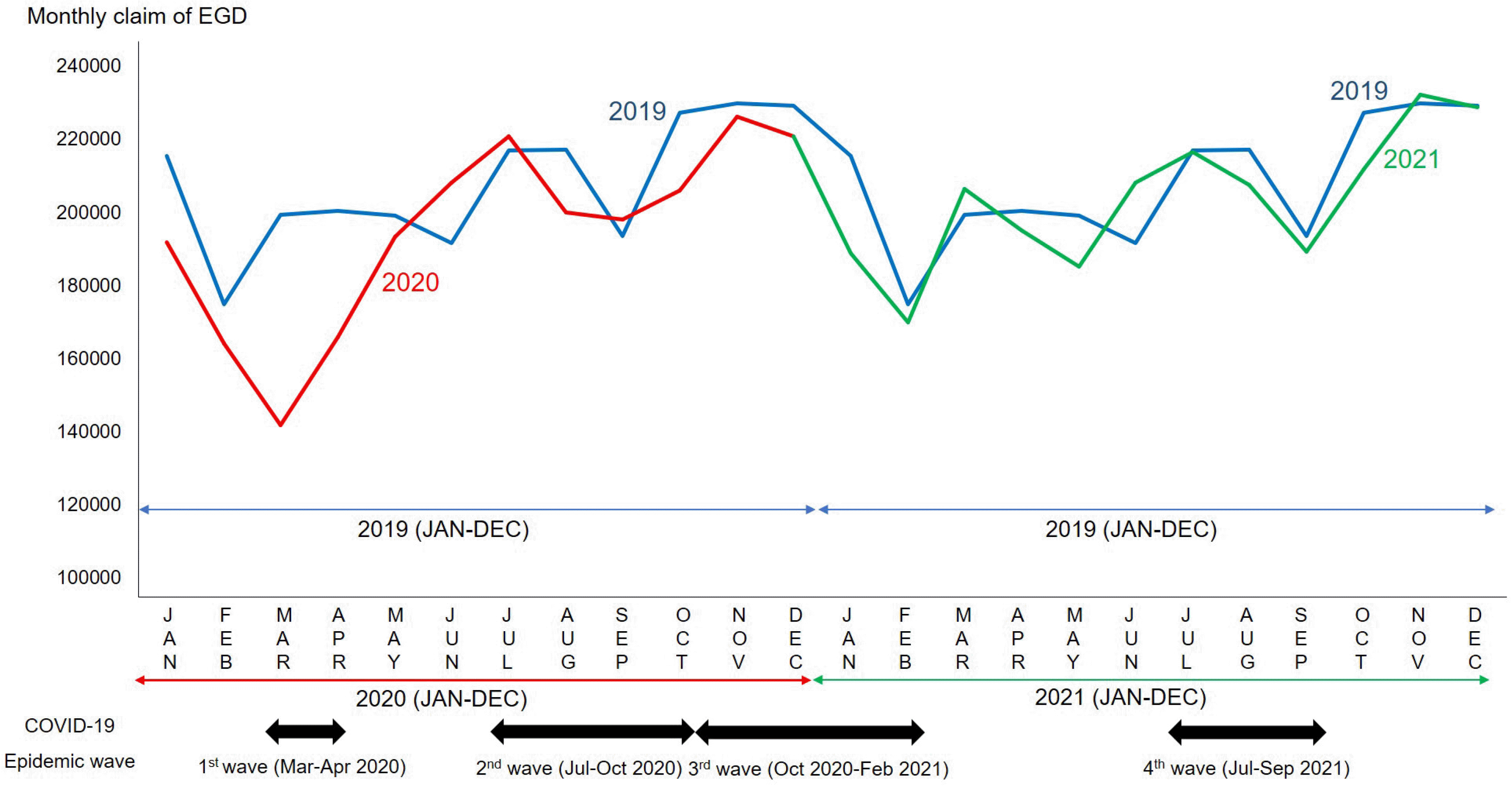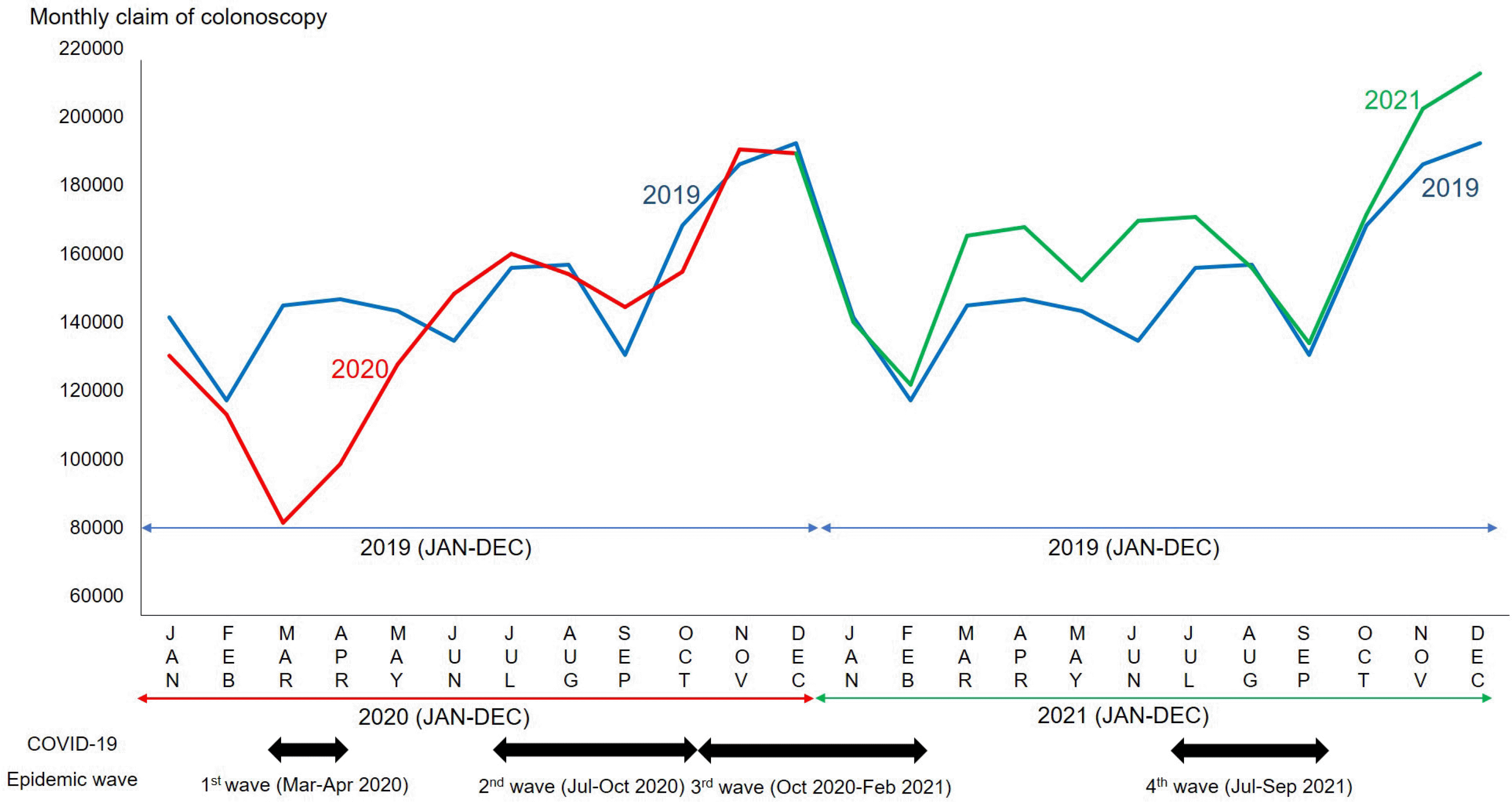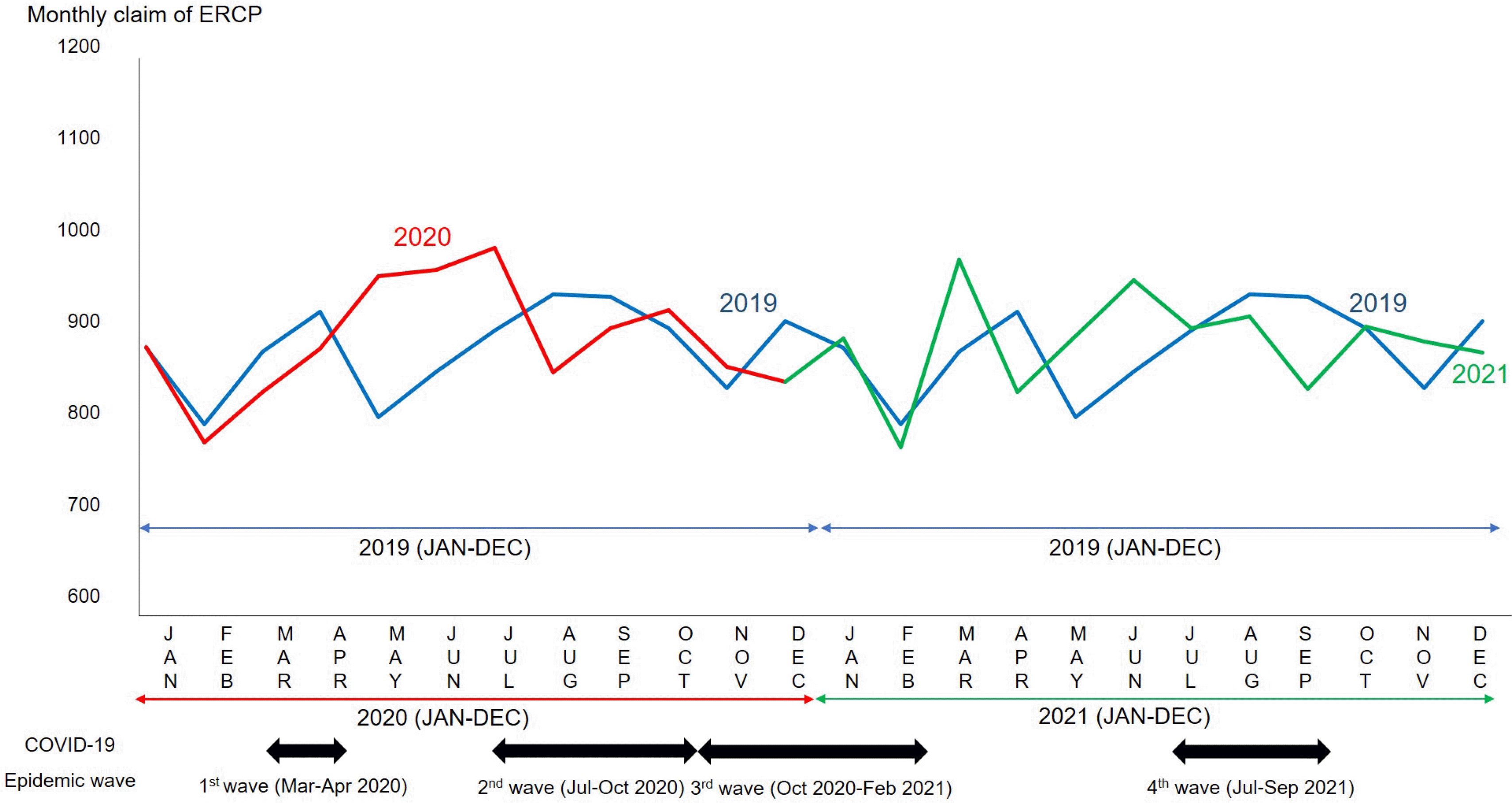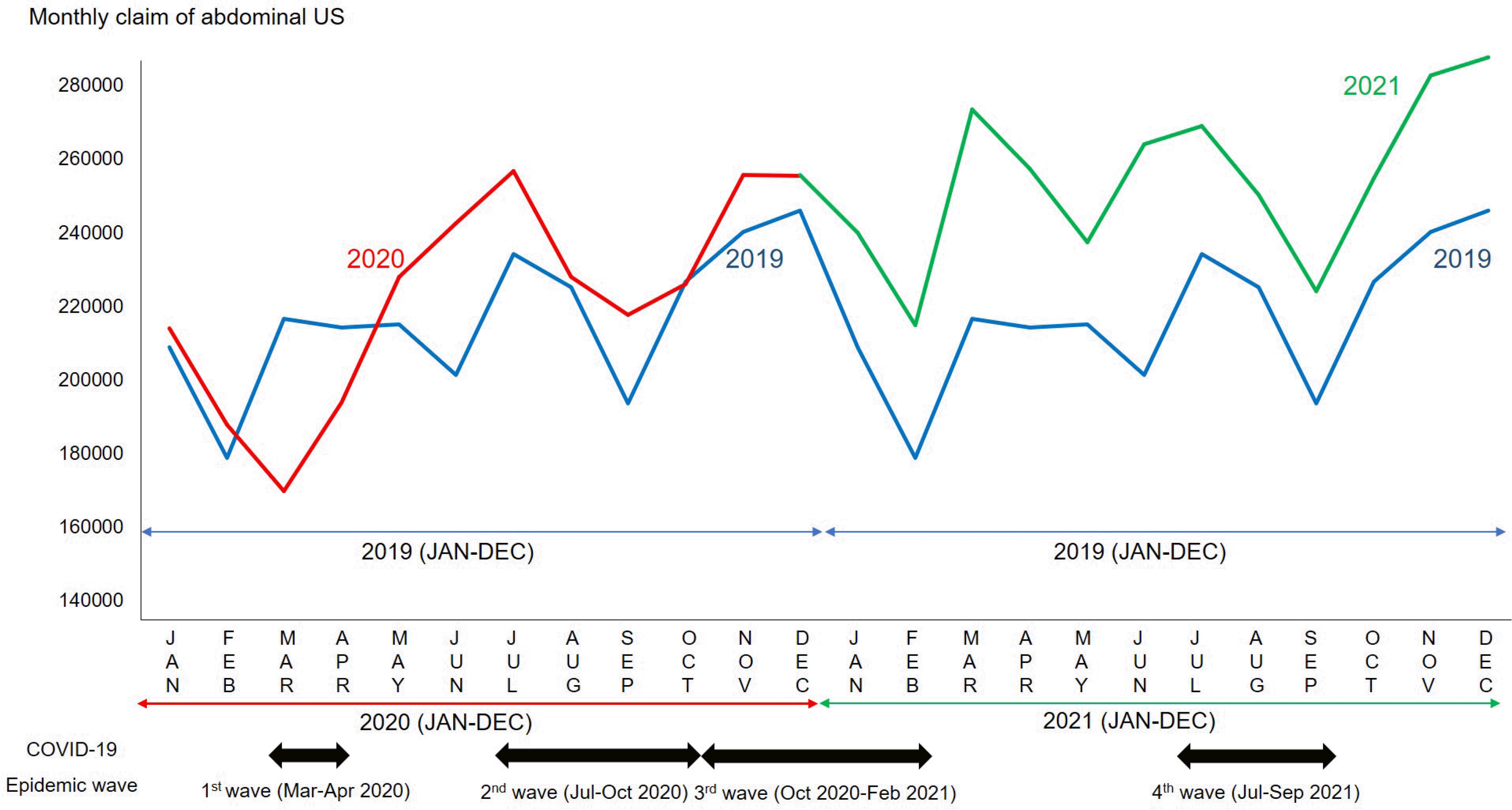Abstract
Background/Aim
Non-time-sensitive gastrointestinal endoscopy was deferred because of the risk of exposure to coronavirus disease 2019 (COVID-19), but no population-based studies have quantified the adverse impact on gastrointestinal procedures. This study examined the impact of the COVID-19 pandemic on the performance of esophagogastroduodenoscopy (EGD), colonoscopy, ERCP, and abdominal ultrasonography (US) in South Korea.
Methods
This nationwide, population-based study compared the claim data of EGD, colonoscopy, ERCP, and abdominal US in 2020 and 2021 (COVID-19 era) with those in 2019 (before the COVID-19 era).
Results
During the first year (2020) of the COVID-19 pandemic, the annual claim data of EGD and colonoscopy were reduced by 6.3% and 6.9%, respectively, but those of ERCP and abdominal US were increased by 1.0% and 2.9%, compared to those in 2019. During the first surge (March and April 2020) of COVID-19, the monthly claim data of EGD, colonoscopy, ERCP, and abdominal US were reduced by 28.8%, 43.8%, 5.1%, and 21.6%, respectively, in March 2020, and also reduced by 17.2%, 32.8%, 4.4%, and 9.5%, respectively, in April 2020, compared to those in March and April 2019. During March and April 2020, the monthly claims of ERCP, compared with those in 2019, declined less significantly than those of EGD and colonoscopy (both p<0.001).
In South Korea, the first case of coronavirus disease 2019 (COVID-19) was confirmed on January 20, 2020.1 After the declaration of the COVID-19 pandemic by the World Health Organization on March 12, 2022, many outbreaks occurred in South Korea between 2020 and 2021. According to the American guidelines, endoscopic procedures, such as esophagogastroduodenoscopy (EGD), ERCP, and colonoscopy, were classified as aerosol-generating procedures, which may generate tiny nuclei droplets in high concentrations and permit the airborne transmission of COVID-19.2 As a result, there were concerns that the COVID-19 pandemic reduced the number of gastrointestinal endoscopy (GIE) procedures. For example, data from England and Hong Kong revealed a decrease in patients who underwent colonoscopy and EGD.3,4 On the other hand, the impact of COVID-19 on GIE could vary significantly from country to country, as the status of COVID-19 varies across countries.5
Abdominal ultrasonography (US) is similar to GIEs in that it is performed face-to-face between the patient and medical staff. Nevertheless, it is a non-aerosolized procedure that can be performed while wearing a mask. Therefore, the impact of the COVID-19 pandemic on abdominal US may differ from those in GIEs. The American guidelines recommended that non-time-sensitive procedures, such as screening or surveillance endoscopies, should be delayed in asymptomatic patients during the COVID-19 pandemic.2 As a result, many non-time-sensitive procedures were deferred because of the risk of exposure to COVID-19.6 Therefore, the magnitude of the negative impact of the COVID-19 pandemic on GIE may be different from their time-sensitive characteristics. On the other hand, no population-based studies have quantified these issues in gastrointestinal procedures. A better understanding of the COVID-19 impact on gastrointestinal procedures may be the first step toward the successful rearrangement of medical resources.
This study examined the impact of the COVID-19 pandemic on gastrointestinal procedures using population-based data in South Korea.
In South Korea, the National Health Insurance program has covered almost 98% of the total population with universal health coverage.7,8 All healthcare providers and Koreans must be covered under the NHI program based on a fee-for-service.8 Health Insurance Review and Assessment (HIRA) data is generated to reimburse providers and contains comprehensive information on the relevant healthcare services, including prescriptions and procedures, such as surgeries, examinations, and treatment.8 Procedure codes in the HIRA databases had a very high level of agreement with the data in medical charts. This was a retrospective nationwide population-based study using the HIRA database in South Korea. The index date for extracting the study data from the HIRA database was August 1, 2022. The requirement for informed consent was waived because the information in this study was related only to pseudonyms. This study was approved by the Institutional Review Board of Kyung Hee University Hospital in Gangdong, Seoul, Republic of Korea (IRB number: KHNMC 2022-05-040).
This was a retrospective nationwide population-based study using the HIRA database of South Korea. For this study, the period from January 1, 2020, to December 31, 2021, was defined as the COVID-19 period because the first case of COVID-19 was reported in January 2020, and many outbreaks continued during 2020 and 2021. The annual claim data of EGD, colonoscopy, ERCP, and abdominal US during the COVID-19 period (2020–2021) were compared with the results of the same period in 2019 as a reference. For a monthly comparison during the first surge of COVID-19, monthly claim data for March and April 2019 were compared with those of the same months in 2020 and 2021.
The first surge period of COVID-19 was defined as March and April 2020 because there was an initial peak of COVID-19 cases, and the Korean government implemented the first social distancing policy.9 The second epidemic wave started from July to October 2020 with the mass infection at a church in Seoul, and the Korean government upgraded the social distancing to level 2 in the Seoul metropolitan area.9 During October 2020 to February 2021, the third epidemic wave started with a gradual increase in the number of COVID-19 cases, and the social distancing level was upgraded twice on 1 and 8 December 2020. The fourth epidemic wave started from July to September 2021, with 2,000–4,000 new COVID-19 cases daily. During the COVID-19 era, the Korean government offered guidance on the changes in standard medical practices to minimize COVID-19 transmission, and many Koreans postponed non-urgent GIE, which may increase the risk of exposure to COVID-19.2 Medical institutions also reduced the performance of GIE due to major workloads from COVID-19 management.2
The most common procedures in the gastroenterology department are EGD, colonoscopy, ERCP, and abdominal US. Based on the HIRA claim codes, GIEs were defined as follows: EGD, EGD without therapeutic intervention (E7611); colonoscopy, colonoscopy without polypectomy (E7660); ERCP, ERCP without therapeutic intervention (E7621 or E7622). Compared with the aerosolized GIEs, abdominal US was analyzed as a control procedure because it is a non-aerosolized procedure performed while wearing a mask. Abdominal US was defined as abdominal US without a pelvic examination (EB441). Abdominal US may include all abdominal US with a pelvic examination (EB441-EB457, EB458), but the pelvic US for women was reimbursed from February 1, 2020, which resulted in the increased claim for abdominal US with pelvic examination from February 2020 in women (Supplementary Table 1). This study used abdominal US without a pelvic examination for a precise comparison of the claims data in abdominal US between 2019 and 2021.
A ‘time-sensitive procedure’ was defined as one that, if deferred, may adversely impact a patient’s important outcomes by the American Gastroenterological Association.2 Time-sensitive procedures may threaten the patient’s life or cause permanent dysfunction of an organ, e.g., diagnosis and treatment of cholangitis. In contrast, a ‘non-time sensitive procedure’ has no short-term impact on patient-important outcomes, e.g., screening or surveillance colonoscopy.2 Therefore, ERCP is considered a time-sensitive procedure, and EGD, colonoscopy, and abdominal US are considered non-time-sensitive procedures.
The claim data are presented as the annual and monthly number of claims in 2019–2021. Descriptive analysis was performed on the entire population during the study period. Annual or monthly comparative analysis between the two groups was conducted using the Chi-squared tests. All statistical tests were two-sided, and a p-value <0.05 was considered significant. All statistical analyses were conducted using the R software package R (R Foundation for Statistical Computing, Vienna, Austria; https://www.r-project.org/).
The annual claim data of EGD in 2020 and 2021 was reduced by 6.3% and 2.2%, respectively, compared to that in 2019 (Table 1). The annual claim data of EGD in 2020 and 2021 was reduced by 6.2% and 2.4% in men, respectively, and by 6.4% and 2.1% in women, respectively, compared to that in 2019 (both p=NS). The monthly claim data of EGD was reduced dramatically on the 1st epidemic wave and less affected on the 2nd–4th epidemic waves during the COVID-19 pandemic (Fig. 1). During the first surge of COVID-19, the monthly claim data of EGD was reduced by 28.8% in March 2020 and 17.2% in April 2020 compared to that in March and April 2019. In March 2020, the monthly claim data of EGD declined by 26.1% and 31.5% in men and women, respectively, compared to March 2019 (p<0.001). In April 2020, the monthly claim data of EGD declined by 17.8% and 16.6% in men and women, respectively, compared with that in April 2019 (p=0.029).
The annual claim data of colonoscopies in 2020 and 2021 were reduced by 6.9% and increased by 8.0%, respectively, compared to that in 2019 (Table 2). The annual claim data of colonoscopy in 2020 and 2021 was reduced by 7.6% and increased by 6.1% in men, respectively, and reduced by 6.2% and increased by 10.0% in women, respectively, compared to that in 2019 (both p<0.001). The monthly claim data for colonoscopies was reduced dramatically during the 1st epidemic wave and less affected during the 2nd and 4th epidemic waves during the COVID-19 pandemic (Fig. 2). During the first surge period of COVID-19, the monthly claim data of colonoscopies was reduced by 43.8% in March 2020 and by 32.8% in April 2020, compared with that in March and April 2019. In March 2020, the monthly claim data of colonoscopies declined by 41.4% and 46.2% in men and women, respectively, compared to that in March 2019 (p<0.001). In April 2020, the monthly claim data of colonoscopies declined by 33.4% and 32.1% in men and women, respectively, compared with that in April 2019 (p=0.016).
The annual claim data of ERCP in 2020 and 2021 increased by 1.0% and 0.8%, respectively, compared to that in 2019 (Table 3). The annual claim data of ERCP in 2020 and 2021 was increased by 3.8% and 1.3% in men, respectively, and reduced by 2.7% and increased by 0.2% in women, respectively, compared to that in 2019 (p=0.021 and p=NS, respectively). The monthly claim data of ERCP was virtually unaffected on the 1st–4th epidemic waves during the COVID-19 pandemic (Fig. 3). During the first surge period of COVID-19, the monthly claim data of ERCP was reduced by 5.1% and 4.4% in March 2020 and April 2020, respectively, than in March and April 2019. In March 2020, the monthly claim data of ERCP declined by 3.8% in men and 6.9% in women compared to that in March 2019 (p=NS). In April 2020, the monthly claim data of ERCP increased by 1.6% in men and declined by 12.1% in women, compared to that in April 2019 (p=NS).
The annual claim data of abdominal US in 2020 and 2021 increased by 2.9% and 17.5%, respectively, compared to that in 2019 (Table 4). The annual claim data of abdominal US in 2020 and 2021 was increased by 2.1% and 15.3% in men, respectively, and was increased by 3.6% and 19.5% in women, respectively, compared to that in 2019 (both p<0.001). The monthly claim data of abdominal US were reduced dramatically on the 1st epidemic wave and less affected during the 2nd–4th epidemic waves during the COVID-19 pandemic (Fig. 4). During the first surge period of COVID-19, the monthly claim data of abdominal US was reduced by 21.6% and 9.5% in March 2020 and April 2020, respectively, compared to that in March and April 2019. In March 2020, the monthly claim data of abdominal US declined by 19.9% and 23.1% in men and women, respectively, compared to that in March 2019 (p<0.001). In April 2020, the monthly claim data of abdominal US declined by 10.7% and 8.6% in men and women, respectively, compared to that in April 2019 (p<0.001).
The annual claim data of ERCP in 2020 decreased less significantly than those of EGD and colonoscopy (both p<0.001) (Table 5). The monthly claim data of ERCP in March 2020 showed a significantly smaller decrease than those of EGD, colonoscopy, and abdominal US (all p<0.001). The change in monthly claims of ERCP in April 2020 also decreased less significantly than those of EGD and colonoscopy (both p<0.001).
This nationwide population-based study was the first Asian study to examine the impact of COVID-19 on GIE and abdominal US. The annual claim data of EGD and colonoscopy in 2020 were reduced by 6.3% and 6.9%, respectively, but those of ERCP and abdominal US in 2020 increased by 1.0% and 2.9%, respectively, than those in 2019. During the first surge of COVID-19, the monthly claim data of EGD, colonoscopy, ERCP, and abdominal US were reduced by 28.8%, 43.8%, 5.1%, and 21.6%, respectively, in March 2020, and by 17.2%, 32.8%, 4.4%, and 9.5% in April 2020, respectively, compared to those in March and April 2019. The monthly claims data of ERCP in March and April 2020, compared to those of 2019, was reduced less significantly than those of EGD and colonoscopy. The annual changes in the claims in EGD and colonoscopy during the first surge of COVID-19 in South Korea were consistent with the Western findings.10,11 One notable finding, however, was that the monthly claim data of EGD and colonoscopy were reduced more significantly than those of ERCP and abdominal US during the COVID-19 pandemic because most ERCPs are time-sensitive procedures and abdominal US examinations are non-aerosolized procedures. During the COVID-19 pandemic, non-time-sensitive procedures, such as screening or surveillance endoscopies, were canceled or postponed because of the risk of COVID-19 transmission.12-14 As most ERCPs are time-sensitive procedures, there was no change in the indications or therapeutic interventions of ERCP during the COVID-19 pandemic in South Korea.15
During the first surge of the COVID-19 pandemic (March and April 2020), the monthly claim data of EGD, colonoscopy, and abdominal US were reduced more significantly in women than in men. These sex differences are because women were more likely to perceive COVID-19 as a severe health problem and agree with the restraining public policy measures.16,17 In addition, women appear to score higher than men in terms of agreeability and conscientiousness. They are more willing to comply with preventive health behaviors, such as social distancing, personal hygiene, and wearing a mask.18 On the other hand, there was no sex difference for ERCP, possibly because of their time-sensitive characteristics compared to EGD and colonoscopy. In Western countries, there were concerns that delayed GIE during COVID-19 may worsen the oncologic outcomes after the end of the COVID-19 pandemic.10,19-21 A recent study reported that CRC screening delays beyond 12 months would significantly increase advanced CRC cases and their mortality.19 A surgical resection may be delayed three months without worsening oncologic outcomes for early gastric cancer. On the other hand, there was insufficient evidence to recommend delayed surgery for advanced gastric cancer.20 For gastric cancer, delayed surgery up to two months after the end of the staging process did not worsen the oncological outcomes.21 As the reduced performance of GIE was recovered within three months during the COVID-19 pandemic, the oncologic outcomes for gastrointestinal cancers may not have worsened during the COVID-19 pandemic in South Korea.
The HIRA database was used to assess the impact of COVID-19 on GIE, and the results were virtually free from referral bias and were readily generalizable owing to the population- based design. Nevertheless, this study had some limitations. First, data derived from administrative coding systems have inherent limitations regarding miscoding or data entry errors. One of the limitations of this study was the secondary data with uncertainty regarding the indication of each procedure. On the other hand, previous studies using HIRA as a data source showed that procedures and diagnoses are coded accurately. Second, no specific details regarding the indication or clinical information of each GIE were recorded in the HIRA. As described in the Methods section, however, HIRA data is reliable because of the universal and nationwide reimbursement system in South Korea. Third, there was a decline in the GIE performance during the COVID-19 pandemic, but the precise reasons for the declined claims were not investigated. Before the COVID-19 pandemic between 2017 and 2019, the annual claim data of endoscopy was rarely changed in South Korea,9 so the effect of COVID-19 may have reduced the use of GIE. Finally, it is difficult to generalize these findings to other countries because the COVID-19 status and healthcare systems differ from country to country.
In conclusion, the claims of EGD and colonoscopy were reduced more significantly than those of ERCP and abdominal US during the COVID-19 pandemic because ERCPs are time-sensitive procedures and abdominal USs are non-aerosolized procedures. These differences should be considered during the next infectious pandemic to rearrange medical resources successfully.
Supplementary material is available at the Korean Journal of Gastroenterology website (https://www.kjg.or.kr/).
Notes
REFERENCES
1. Jee Y, Kim YJ, Oh J, Kim YJ, Ha EH, Jo I. 2022; A COVID-19 mortality prediction model for Korean patients using nationwide Korean disease control and prevention agency database. Sci Rep. 12:3311. DOI: 10.1038/s41598-022-07051-4. PMID: 35228578. PMCID: PMC8885855.

2. Sultan S, Lim JK, Altayar O, et al. 2020; AGA rapid recommendations for gastrointestinal procedures during the COVID-19 pandemic. Gastroenterology. 159:739–758.e4. DOI: 10.1053/j.gastro.2020.03.072. PMID: 32247018. PMCID: PMC7118600.

3. Morris EJA, Goldacre R, Spata E, et al. 2021; Impact of the COVID-19 pandemic on the detection and management of colorectal cancer in England: a population-based study. Lancet Gastroenterol Hepatol. 6:199–208. DOI: 10.1016/S2468-1253(21)00005-4. PMID: 33453763.

4. Lui TKL, Leung K, Guo CG, Tsui VWM, Wu JT, Leung WK. 2020; Impacts of the coronavirus 2019 pandemic on gastrointestinal endoscopy volume and diagnosis of gastric and colorectal cancers: A population-based study. Gastroenterology. 159:1164–1166.e3. DOI: 10.1053/j.gastro.2020.05.037. PMID: 32425228. PMCID: PMC7230139.

5. Chiu HM, Su CW, Hsu WF, et al. 2021; Mitigating the impact of COVID-19 on colorectal cancer screening: Organized service screening perspectives from the Asia-Pacific region. Prev Med. 151:106622. DOI: 10.1016/j.ypmed.2021.106622. PMID: 34044024. PMCID: PMC8443175.

6. Repici A, Maselli R, Colombo M, et al. 2020; Coronavirus (COVID-19) outbreak: what the department of endoscopy should know. Gastrointest Endosc. 92:192–197. DOI: 10.1016/j.gie.2020.03.019. PMID: 32179106. PMCID: PMC7102667.

7. Kim L, Kim JA, Kim S. 2014; A guide for the utilization of Health Insurance Review and Assessment Service National Patient Samples. Epidemiol Health. 36:e2014008. DOI: 10.4178/epih/e2014008. PMID: 25078381. PMCID: PMC4151963.

8. Kim JA, Yoon S, Kim LY, Kim DS. 2017; Towards actualizing the value potential of Korea health insurance review and assessment (HIRA) data as a resource for health research: Strengths, limitations, applications, and strategies for optimal use of HIRA data. J Korean Med Sci. 32:718–728. DOI: 10.3346/jkms.2017.32.5.718. PMID: 28378543. PMCID: PMC5383602.

9. Lee K, Suh M, Jun JK, Choi KS. 2022; Impact of the COVID-19 pandemic on gastric cancer screening in South Korea: Results from the Korean national cancer screening survey (2017-2021). J Gastric Cancer. 22:264–272. DOI: 10.5230/jgc.2022.22.e36. PMID: 36316105. PMCID: PMC9633925.

10. Khan A, Bilal M, Morrow V, Cooper G, Thakkar S, Singh S. 2021; Impact of the coronavirus disease 2019 pandemic on gastrointestinal procedures and cancers in the United States: A multicenter research network study. Gastroenterology. 160:2602–2604.e5. DOI: 10.1053/j.gastro.2021.02.055. PMID: 33662388. PMCID: PMC7919513.

11. Lantinga MA, Theunissen F, Borg PCJT, Bruno MJ, Ouwendijk RJT, Siersema PD. 2021; Impact of the COVID-19 pandemic on gastrointestinal endoscopy in the Netherlands: analysis of a prospective endoscopy database. Endoscopy. 53:166–170. DOI: 10.1055/a-1272-3788. PMID: 33080630. PMCID: PMC7869035.

12. Kim KH, Kim SB, Kim TN. 2021; Changes in endoscopic patterns before and during COVID-19 outbreak: Experience at a single tertiary center in Korean. World J Clin Cases. 9:3576–3585. DOI: 10.12998/wjcc.v9.i15.3576. PMID: 34046457. PMCID: PMC8130062.

13. Mazidimoradi A, Tiznobaik A, Salehiniya H. 2022; Impact of the COVID-19 pandemic on colorectal cancer screening: a systematic review. J Gastrointest Cancer. 53:730–744. DOI: 10.1007/s12029-021-00679-x. PMID: 34406626. PMCID: PMC8371036.

14. Kopel J, Ristic B, Brower GL, Goyal H. 2022; Global impact of COVID-19 on colorectal cancer screening: Current insights and future directions. Medicina (Kaunas). 58:100. DOI: 10.3390/medicina58010100. PMID: 35056408. PMCID: PMC8778776.

15. Kim KH, Kim SB. 2021; Comparison of the impact of endoscopic retrograde cholangiopancreatography between pre-COVID-19 and current COVID-19 outbreaks in South Korea: Retrospective survey. World J Clin Cases. 9:8404–8412. DOI: 10.12998/wjcc.v9.i28.8404. PMID: 34754849. PMCID: PMC8554445.

16. Galasso V, Pons V, Profeta P, Becher M, Brouard S, Foucault M. 2020; Gender differences in COVID-19 attitudes and behavior: Panel evidence from eight countries. Proc Natl Acad Sci U S A. 117:27285–27291. DOI: 10.1073/pnas.2012520117. PMID: 33060298. PMCID: PMC7959517.

17. Tan J, Yoshida Y, Sheng-Kai Ma K, Mauvais-Jarvis F. 2022; Gender differences in health protective behaviors during the COVID-19 pandemic in Taiwan: An empirical study. BMC Public Health. 22:1900. DOI: 10.1186/s12889-022-14288-1. PMID: 36224561. PMCID: PMC9554846.

18. Ek S. 2015; Gender differences in health information behaviour: a Finnish population-based survey. Health Promot Int. 30:736–745. DOI: 10.1093/heapro/dat063. PMID: 23985248.

19. Ricciardiello L, Ferrari C, Cameletti M, et al. 2021; Impact of SARS-CoV-2 pandemic on colorectal cancer screening delay: Effect on stage shift and increased mortality. Clin Gastroenterol Hepatol. 19:1410–1417.e9. DOI: 10.1016/j.cgh.2020.09.008. PMID: 32898707. PMCID: PMC7474804.

20. Fligor SC, Wang S, Allar BG, et al. 2020; Gastrointestinal malignancies and the COVID-19 pandemic: Evidence-based triage to surgery. J Gastrointest Surg. 24:2357–2373. DOI: 10.1007/s11605-020-04712-5. PMID: 32607860. PMCID: PMC7325836.
21. De Rosa M, Pasculli A, Rondelli F, et al. 2021; Could diagnostic and therapeutic delay affect the prognosis of gastrointestinal primary malignancies in the COVID-19 pandemic era? Minerva Surg. 76:467–476. DOI: 10.23736/S2724-5691.21.08736-8. PMID: 33890444.

Fig. 1
The monthly claim data of EGD was reduced dramatically on the 1st epidemic wave and less affected on the 2nd–4th epidemic waves during the COVID-19 pandemic. EGD, esophagogastroduodenoscopy; COVID-19, coronavirus disease 2019.

Fig. 2
The monthly claim data of colonoscopy was reduced dramatically on the 1st epidemic wave and less affected on the 2nd-4th epidemic waves during the COVID-19 pandemic. COVID-19, coronavirus disease 2019.

Fig. 3
The monthly claim data of ERCP was relatively unaffected by the 1st–4th epidemic waves during the COVID-19 pandemic. COVID-19, coronavirus disease 2019.

Fig. 4
The monthly claim data of abdominal US was reduced dramatically on the 1st epidemic wave and less affected on the 2nd–4th epidemic waves during the COVID-19 pandemic. COVID-19, coronavirus disease 2019; US, ultrasonography.

Table 1
Monthly Claim Data of Patients Who Underwent EGDa
Table 2
Monthly Claim Data of Patients Who Underwent Colonoscopya
Table 3
Monthly Claim Data of Patients Who Underwent ERCPa
Table 4
Monthly Claim Data of Patients Who Underwent Abdominal Ultrasonographya
Table 5
Change in the Claim Data in Gastrointestinal Procedures During COVID-19
| Procedures | Total | p-value | Male | p-value | Female | p-value | |
|---|---|---|---|---|---|---|---|
| Annual change of claima (in 2020) | ERCP | +1.0% | Ref. | +3.8% | Ref. | –2.7% | Ref. |
| EGD | –6.3% | <0.001 | –6.2% | <0.001 | –6.4% | <0.001 | |
| Colonoscopy | –6.9% | <0.001 | –7.6% | <0.001 | –6.2% | <0.001 | |
| Abdominal US | +2.9% | 0.191 | +2.1% | 0.373 | +3.6% | 0.004 | |
| First surge of COVID-19 | |||||||
| Monthly change of claima (in March 2020) | ERCP | –5.1% | Ref. | –3.8% | Ref. | –6.9% | Ref. |
| EGD | –28.8% | <0.001 | –26.1% | <0.001 | –31.5% | <0.001 | |
| Colonoscopy | –43.8% | <0.001 | –41.4% | <0.001 | –46.2% | <0.001 | |
| Abdominal US | –21.6% | <0.001 | –19.9% | <0.001 | –23.1% | <0.001 | |
| Monthly change of claima (in April 2020) | ERCP | –4.4% | Ref. | +1.6% | Ref. | –12.1% | Ref. |
| EGD | –17.2% | <0.001 | –17.8% | <0.001 | –16.6% | 0.476 | |
| Colonoscopy | –32.8% | <0.001 | –33.4% | <0.001 | –32.1% | <0.001 | |
| Abdominal US | –9.5% | 0.245 | –10.7% | 0.040 | –8.6% | 0.589 | |




 PDF
PDF Citation
Citation Print
Print



 XML Download
XML Download